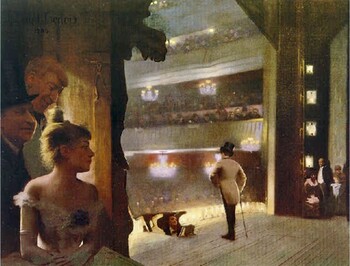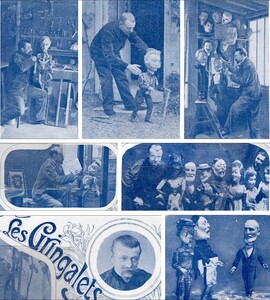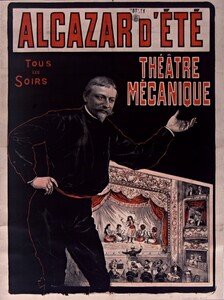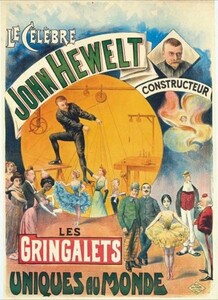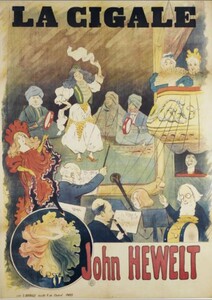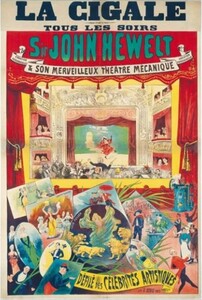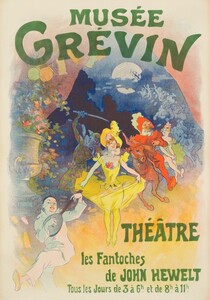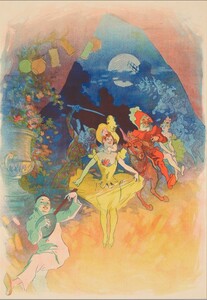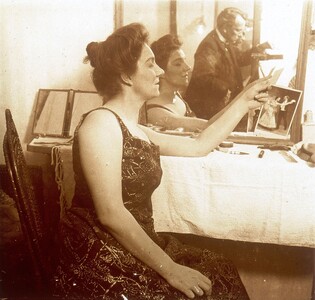6.800 €
Self-portrait with three of his marionettes
Oil on canvas : 62,3 X 51,2 cm
Signed bottom right “John Hewelt / (de St Genois)”
Frame : 90,1 X 79,1 cm
Provenance :
- Unsold at Sotheby’s New York, 8/11/12
- Unsold at Sotheby’s New York, 8/11/12
Estimate : 20.000 - 30.000 $ (+ buyer’s premium)
= 15.618 – 23.427 € (+ buyer’s premium)
- Subsequently with Berko Fine Paintings, Knokke
In short
Our rare painter was the natural son of the Belgian Baronnes Charlotte de Saint-Genois de Grand-Breucq. Under the stage name John Hewelt he was also active as a puppeteer. His astonishing, lively performances were very popular in Paris and also in London. Hewelt sculpted and painted his own marionettes that perfectly performed in the most amusing way like living creatures.
About Charles-Albert de Saint-Genois
Belgian painter
Avesnelles 1861 – 1918 Asnières-sur-Seine
Rare painter of popular entertainment: the circus, the so-called boulevard theatre, bals, popular taverns (“guingettes”, such as the Moulin de la Galette).
He was also active as a marionette puppet master under the pseudonym John Hewelt (an English alias, as he walked in the footsteps of an Englishman, John Holden, whose performances were very popular in Paris).
His mother, the Belgian Baronnes Charlotte de Saint-Genois de Grand-Breucq was born in Ath in 1830, she passed away in 1900. She had three natural children who therefore had no legal rights to her title:
- Hippolyte (1853 – 1911)
- Paul-Alfred (1857 – 1939)
- our painter, Charles-Albert (1861-1918).
She first settled just over the border, in Northern France (Avesnelles), since 1869 near Paris, in Asnières, on the left bank of the River Seine. The village was a favourite subject of the Impressionist (Monet and Renoir) and Post-Impressionist (Signac and van Gogh) painters.
Charles-Albert was officially recognized by his mother as her son in Paris, 27/12/1873.
Pupil of the Ecole des Beaux-Arts in Paris.
Started exhibiting paintings at the Salon in Paris in 1885.
Charles-Albert was strongly influenced by his brother, Paul-Alfred, who was a popular magician known as Dicksonn. In 1882 Dicksonn had started creating 45 cm high puppets (“fantoches artistiques”) that were activated by 35 different, invisible wires each. Later in his career he specialised in revealing magic tricks, especially in unmasking spiritualists, whom he called “charlatans and exploiters of public credulity”.
Hewelt’s own productions, for example at the Theatre of the Musée Grévin, included marionettes based on famous performers of the day and included a full puppet orchestra and puppet spectators in theatre boxes. Other productions were political satires (see the puppets in our painting)
Hewelt sculpted and painted himself his puppets, which were cleverly articulated for he had developed a system of aerial recall wires in addition to splint wires. His own wife and son helped him to manipulate the marionettes, which he called “gringalets”, meaning “small, puny figures”.
The three gringalets in our painting must represent King Leopold II of Belgium (1835 – 1909), the authoritarian, anti-French Italian prime minister Francesco Crispi (1818 – 1901) and the famous French cabaret singer Yvette Guilbert (1865 – 1944). Yvette Guilbert was of course regularly portrayed by the famous Post-Impressionist painter, caricaturist and illustrator Henri de Toulouse-Lautrec (1864 – 1901) who was also active at the same time as our painter in Montmartre’s cabarets and café-concerts. Sadly I did not find any link with our painter/puppet show performer.
Why should you buy this painting?
Because this marvellous self-portrait breathes the bohemian atmosphere of Montmartre, around the Place Pigalle circa 1900.
Comparative paintings
Click photos for more details

